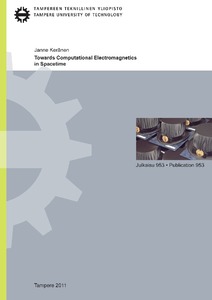Towards computational electromagnetics in spacetime
Keränen, Janne (2011)
Keränen, Janne
Tampere University of Technology
2011
Tieto- ja sähkötekniikan tiedekunta - Faculty of Computing and Electrical Engineering
This publication is copyrighted. You may download, display and print it for Your own personal use. Commercial use is prohibited.
Julkaisun pysyvä osoite on
https://urn.fi/URN:NBN:fi:tty-201104041171
https://urn.fi/URN:NBN:fi:tty-201104041171
Tiivistelmä
In this work, we developed a geometric computational method for electromagnetic wave problems. The method unifies the spatial and temporal discretizations and produces a four-dimensional spacetime computational scheme, which treats spatial and time dimensions equally.
This new method seeks primarily to develop the current geometric methods, i.e., the finite integration technique and the cell method. We introduce some improvements to these methods and, additionally, develop tools for further development. For these, we present a couple of challenge problems and largely solve them with our method in this thesis.
There are several reasons why we focus on the mathematical structures underlying the spacetime and electromagnetic models. For example, first, four-dimensional fields cannot be modeled with elementary vector algebra, and, second, a functional computational method is usually based on a solid mathematical foundation. From the background of the theory of relativity, we develop a model for spacetime. Because this model includes an indefinite metric, all metric-dependent concepts must agree with this non-Riemannian indefinite metric. Consequently, we utilize concepts new to electromagnetic computation. And because our target is electromagnetic computation, we choose a model that agrees well with computation: we model electromagnetic fields with cochains.
In the end, we introduce a computational method that makes use of a pair of four-dimensional Lorentzian orthogonal meshes. In developing it, we concentrate on the constitutive relations, boundary conditions, and gauging methods and implement the method and demonstrate it with several examples.
This new method seeks primarily to develop the current geometric methods, i.e., the finite integration technique and the cell method. We introduce some improvements to these methods and, additionally, develop tools for further development. For these, we present a couple of challenge problems and largely solve them with our method in this thesis.
There are several reasons why we focus on the mathematical structures underlying the spacetime and electromagnetic models. For example, first, four-dimensional fields cannot be modeled with elementary vector algebra, and, second, a functional computational method is usually based on a solid mathematical foundation. From the background of the theory of relativity, we develop a model for spacetime. Because this model includes an indefinite metric, all metric-dependent concepts must agree with this non-Riemannian indefinite metric. Consequently, we utilize concepts new to electromagnetic computation. And because our target is electromagnetic computation, we choose a model that agrees well with computation: we model electromagnetic fields with cochains.
In the end, we introduce a computational method that makes use of a pair of four-dimensional Lorentzian orthogonal meshes. In developing it, we concentrate on the constitutive relations, boundary conditions, and gauging methods and implement the method and demonstrate it with several examples.
Kokoelmat
- Väitöskirjat [4772]
